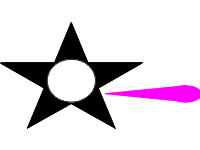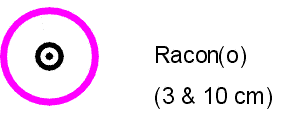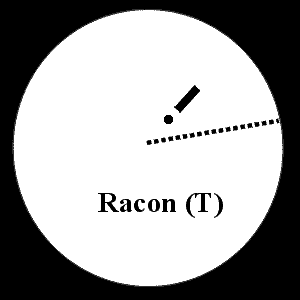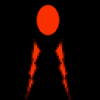If a navigation mark is lit, it will have a magenta teardrop shape extending from the base of the chart symbol. The direction of it has no significance; it is printed where it will not obscure other detail.

The details of a light will be written alongside the buoy:
F means a fixed light (not normally found on a buoy).
Fl means flashing.
R means a red light.
G means a green light.
Y means a yellow light.
No letter for colour indicates that the light is white.
Red and green lights are reserved for lateral marks and yellow for special marks. White lights are used for other types of marks. It is possible that some shore lights that are not part of the IALA scheme may have similar characteristics to to those used in the buoyage system. Special care should be taken when they are sighted to ensure they are correctly identified.
The position of a major light, on an object which is not afloat (beacons and lighthouses), is indicated by a symbol like this:

An example is the lighthouse at Cape Donne (Chart 3, 46 ° 00.42'N 06° 17.73'W). The light is at the centre of the small white circle. The information given is: Cape Donne Fl(3)10s 68m 19M Horn(1)10s.
This means that the main light is white (there is no colour given) and flashes 3 times in 10 seconds. With a nominal range of 19M (this is the range when meteorological visibility is 10M) and the plane of the light is 68 metres above MHWS. There is also a foghorn that sounds once in 10 seconds.
 |
|
A major lighthouse. |
The position of a minor light that is not afloat; is indicated by the symbol below. This may be used for the light on the end of a pier. There is an example on Chart 4E, in Namley Harbour (46°25.37'N 05°46.78'W), this is an Quick Flashing red light, see below for an explanation.

The ends of jetties or piers are normally marked by 2 fixed lights mounted vertically on a pole. This would often be marked by a symbol for a minor light and may include the legend:
2FR(vert) or 2FG(vert)
An example can be found on chart 4D at (46°24.386'N 06°00.82'W)
Light ranges
Major lights will have the range of the light indicated on a chart.
The range of lights on buoys are never indicated (except on LANBYs), but on a clear night, the maximum range that you can expect to see a lit buoy will be 3 miles, frequently the visible range will be considerably less.
At night, there is always a danger of hitting a buoy, because the distance off is very hard to determine. This is a particular danger when the tide and wind are carrying the vessel on to the buoy. There are 2 visual clues to how far you are from a buoy: At about ½ mile, the light will rise up from the horizon. At about 200m, the light will reflect in the surface.
|
|
|
|
|
Buoy at less than 3 miles. |
Buoy at less than 1/2 mile. |
Buoy at less than 200m. |
Once you can see the light's reflection, you must ensure that the buoy is moving relative to the background to avoid a collision.
Light sequences
There are many possible light sequences; this means that each buoy can have a distinctive pattern to ensure it is easily differentiated from any other. The time period given is always for the whole period of light and dark.
A prudent navigator will get one of the crew to independently check any light sequences. It is easy to convince yourself that you have correctly identified a light, especially when in difficult conditions or when tired.
F Fixed; The light is on all the time.

Fl Flashing; The light is off and then flashes on for a set number of flashes.

LFl Long flash; The light is off, and gives a long flash.

Q Quick; A light that flashes about once per second.

VQ Very Quick; A light that flashes about twice per second.

Iso Isophase; The light is on for the same period as it is off (in this case 5 seconds each).

Oc Occulting; The light is on and then flashes off for a set number of flashes.

Mo Morse; The light flashes a letter in the Morse code. 'A', dot dash is common or occasionally 'U', dot dot dash.

Sound signals
Many buoys have bells or whistles; these are operated by the motion of the buoy in the sea, and can be a great comfort on a foggy day. In Britain, many of the major fog signals which were positioned on lighthouses are being phased out as a cost cutting measure, there are still some in use and their details are printed on the chart.
Racons
Some navigation marks are fitted with a Racon; this is a Radar transponder beacon. When it receives a radar pulse from a ship, it transmits a return signal, which appears on the ship's radar screen as a letter in the Morse code, emanating from the radar echo of the buoy. The signal letter is often written beside the buoy on the chart.

The 3 & 10 cm refers to the wavelengths of the radar set that the racon responds to. An example of a racon is the LCW buoy on Chart 3 at 46°02.78'N 05°57.58'W.

Sailtrain.co.uk is free to use, but if you feel you would like to contribute to the running and development costs you can donate via Paypal:
Additional Resources:



